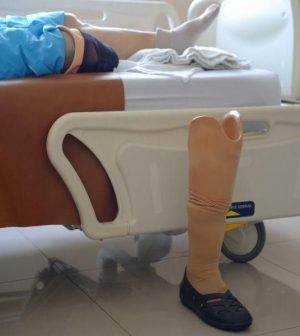- Understanding the Connection Between Anxiety and Depression
- How Daily Prunes Can Influence Cholesterol and Inflammation
- When to Take B12 for Better Absorption and Energy
- Epsom Salts: Health Benefits and Uses
- See What Saffron Can Do for Sleep and Heart Health
- 6 Common Mistakes to Avoid Before Your Physical
- Can Sweating Really Help You Beat a Cold?
- Strengthening Your Relationship: Practical Strategies
- Skip Storing This Everyday Product in the Fridge Door
- Green Tea + B3 Pairing May Boost Brain Health
Diabetes Can Lead to Amputations, But Stem Cell Treatment Offers Hope

One of the most dangerous complications of diabetes is a foot ulcer that won’t heal, but now a preliminary study finds that a type of stem cell found in body fat may be a powerful remedy for these severe foot wounds.
The study included 63 patients with non-healing diabetic foot ulcers who were given injections of cells from their own body fat. Over the next year, the treatment healed the ulcers in most patients.
Researchers said the study — conducted in Nicaragua — lays the groundwork for a similar trial in the United States, to replicate the findings.
Diabetic foot ulcers are open sores or wounds that affect roughly 15% of people with diabetes, according to the American Podiatric Medical Association (APMA). For some, the wounds refuse to heal and can become infected — sometimes leading to amputation.
In the United States alone, studies show that more than half of all amputations are diabetes-related — and non-healing foot ulcers are usually the reason why.
People with diabetes are vulnerable to foot ulcers for several reasons, explained study author Dr. Michael Carstens.
Over time, chronically high blood sugar can damage nerves in the feet, leading to a loss of sensation. That means sores or cuts can go unnoticed until they worsen and become infected. Making matters worse, diabetes damages the body’s small blood vessels, which impairs blood flow to the feet — interfering with the natural wound-healing process.
On top of that, many people with diabetes also have blockages in larger arteries, including those in the legs, said Carstens, of Wake Forest University’s Institute for Regenerative Medicine, in Winston-Salem, N.C.
Diabetic foot ulcers can often be treated with measures like applying medication or dressings to the wound, as well as surgical debridement — where a doctor removes dead skin and tissue to create a “new” wound that may heal better.
Still, the APMA says, around 6% of people with diabetic ulcers end up in the hospital due to an infection or other complication.
For their study, Carstens’ team turned to stem cells to try to heal severe wounds in diabetes patients who were candidates for amputation.
“They had critical-size wounds,” Carstens noted. “There was no way they were going to heal on their own.”
Specifically, researchers harvested a collection of cells called stromal vascular fraction from patients’ body fat. Among that collection is a type of “adult” stem cell called mesenchymal stem cells (MSCs).
MSCs give rise to certain more mature cell types, including cartilage and muscle.
Researchers injected the cells into and around patients’ wounds, and along arteries in the lower leg. Six months later, 51 of the 63 patients were showing complete closure of the ulcer, while another eight had at least a 75% closure.
Of the remaining four, three needed amputations and one died — from heart complications unrelated to the treatment, the researchers said.
One year out, 50 patients had completely healed wounds, while another four had at least 85% healing. The remaining five patients had died — also from heart-related causes.
According to Carstens, MSCs appear to work by producing chemicals that spur new blood vessel growth, allowing for wound repair.
The findings were recently published in the journal Stem Cells Translational Medicine.
The general tactic of using stem cells for diabetic foot ulcers is not new; doctors can already use cells derived from the amniotic membrane of the placenta.
Dr. Jeffrey Ross, an APMA spokesman, said he’s personally found amniotic membrane cells to be very effective in wound healing.
The cells are retrieved from the placenta of babies born by cesarean section, explained Ross, who is also an associate professor of surgery at Baylor College of Medicine in Houston.
Various companies market products containing frozen or dehydrated amniotic membrane cells that can be applied to diabetic foot ulcers.
Ross did say the wound healing in the new study was “impressive.” In three patients who’d had wounds so severe their tendons were exposed, the newly developed tissue was capable of covering the tendons — which he pointed out is difficult to achieve.
Ross added, though, that he would have liked to see more intensive follow-up of the patients. The intervals between evaluations were “too far apart,” he said.
It’s not clear whether cells derived from patients’ fat could be any better than the amniotic cells already on the market, according to Ross. It would take head-to-head studies to determine that, he said.
But in general, Ross said, cell-based therapies — harnessing the body’s own healing powers — are the wave of the future.
More information
The American Podiatric Medical Association has more on diabetic foot ulcers.
SOURCES: Michael Carstens, MD, PhD, assistant instructor, Institute for Regenerative Medicine, Wake Forest University, Winston-Salem, N.C.; Jeffrey Ross, MD, DPM, associate professor, surgery, Baylor College of Medicine, Houston; Stem Cells Translational Medicine online, April 7, 2021
Source: HealthDay
Copyright © 2026 HealthDay. All rights reserved.










